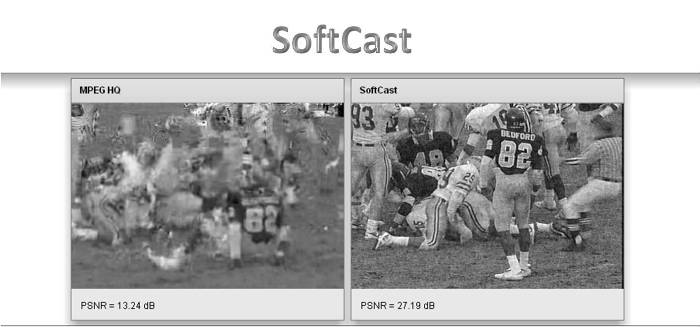PROJECT WEBPAGE
Go to Project's Main Webpage:
http://people.csail.mit.edu/szym/softcast/videos.html
Project Demo:
http://caterpillar.csail.mit.edu/~szym/flex/demo.swf
overview
Today’s mobile video suffers from two limitations: 1) it cannot reduce bandwidth consumption by leveraging wireless broadcast to multicast popular content to interested receivers, and 2) it lacks robustness to wireless interference and errors. This project presents SoftCast, a cross-layer design for mobile video that addresses both limitations. To do so, SoftCast changes the network stack to act like a linear transform. As a result, the transmitted video signal becomes linearly related to the pixels’ luminance. Thus, when noise perturbs the transmitted signal samples, the perturbation naturally translates into approximation in the original video pixels. This enables a video source to multicast a single stream that each receiver decodes to a video quality commensurate with its channel quality. It also increases robustness to interference and errors which now reduce the sharpness of the received pixels but do not cause the video to glitch or stall. We have implemented SoftCast and evaluated it in a testbed of software radios. Our results show that it improves the average video quality for multicast users by 5.5 dB, eliminates video glitches caused by mobility, and increases robustness to packet loss by an order of magnitude.
papers
A Cross-Layer Design for Scalable Mobile Video
Szymon Jakubczak and Dina Katabi
ACM MOBICOM, 2011. PDF
One-Size-Fits-All Wireless Video,
Szymon Jakubczak, Hariharan Rahul, and Dina Katabi,
ACM HotNets, October 2009.PDF
people
Szymon Jakubczak
Google Inc.
Dina Katabi
Massachusetts Institute of Technology
Hariharan Rahul
Massachusetts Institute of Technology





